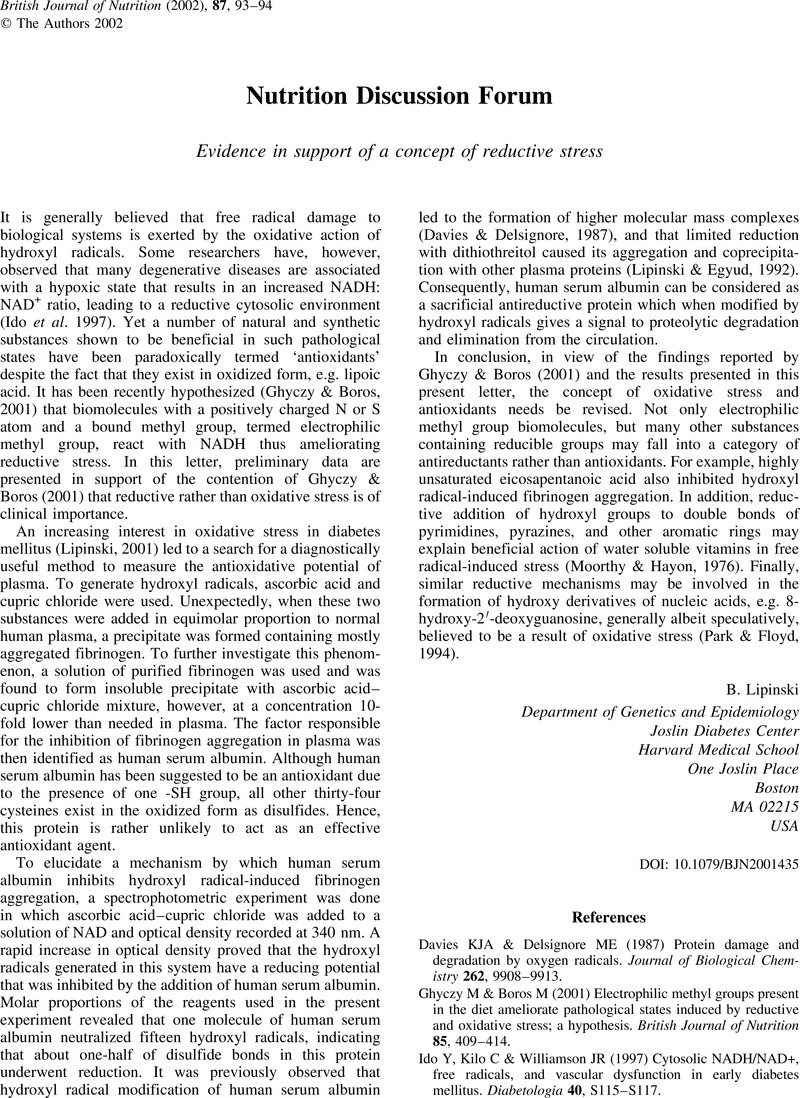Crossref Citations
This article has been cited by the following publications. This list is generated based on data provided by Crossref.
Ghyczy, Miklós
and
Boros, Mihály
2002.
Evidence in support of a concept of reductive stress - Reply by Ghyczy & Boros.
British Journal of Nutrition,
Vol. 87,
Issue. 1,
p.
94.
Ghyczy, Miklós
Torday, Csilla
and
Boros, Mihály
2003.
Simultaneous generation of methane, carbon dioxide, and carbon monoxide from choline and ascorbic acid ‐ a defensive mechanism against reductive stress?.
The FASEB Journal,
Vol. 17,
Issue. 9,
p.
1124.
Moldovan, Leni
and
Moldovan, Nicanor I.
2004.
Oxygen free radicals and redox biology of organelles.
Histochemistry and Cell Biology,
Vol. 122,
Issue. 4,
p.
395.
Lipinski, Boguslaw
2004.
Markers of oxidative stress in uremia.
Kidney International,
Vol. 65,
Issue. 1,
p.
339.
Versari, Daniele
Daghini, Elena
Rodriguez-Porcel, Martin
Sattler, Katherine
Galili, Offer
Pilarczyk, Kevin
Napoli, Claudio
Lerman, Lilach O.
and
Lerman, Amir
2006.
Chronic Antioxidant Supplementation Impairs Coronary Endothelial Function and Myocardial Perfusion in Normal Pigs.
Hypertension,
Vol. 47,
Issue. 3,
p.
475.
Kadlcik, Vojtech
Sicard‐Roselli, Cécile
Houée‐Levin, Chantal
Kodicek, Milan
Ferreri, Carla
and
Chatgilialoglu, Chryssostomos
2006.
Reductive Modification of a Methionine Residue in the Amyloid‐β Peptide.
Angewandte Chemie International Edition,
Vol. 45,
Issue. 16,
p.
2595.
Lipinski, Boguslaw
and
Sajdel-Sulkowska, Elizabeth M.
2006.
New Insight into Alzheimer Disease: Demonstration of Fibrin(ogen)-serum Albumin Insoluble Deposits in Brain Tissue.
Alzheimer Disease & Associated Disorders,
Vol. 20,
Issue. 4,
p.
323.
Kadlcik, Vojtech
Sicard‐Roselli, Cécile
Houée‐Levin, Chantal
Kodicek, Milan
Ferreri, Carla
and
Chatgilialoglu, Chryssostomos
2006.
Reductive Modification of a Methionine Residue in the Amyloid‐β Peptide.
Angewandte Chemie,
Vol. 118,
Issue. 16,
p.
2657.
Ferreri, Carla
Manco, Immacolata
Faraone‐Mennella, M. Rosaria
Torreggiani, Armida
Tamba, Maurizio
Manara, Sonia
and
Chatgilialoglu, Chryssostomos
2006.
The Reaction of Hydrogen Atoms with Methionine Residues: A Model of Reductive Radical Stress Causing Tandem Protein–Lipid Damage.
ChemBioChem,
Vol. 7,
Issue. 11,
p.
1738.
Mozziconacci, Olivier
Bobrowski, Krzysztof
Ferreri, Carla
and
Chatgilialoglu, Chryssostomos
2007.
Reactions of Hydrogen Atoms with Met‐Enkephalin and Related Peptides.
Chemistry – A European Journal,
Vol. 13,
Issue. 7,
p.
2029.
Charles, Rebecca L.
and
Eaton, Philip
2008.
Redox signalling in cardiovascular disease.
PROTEOMICS – Clinical Applications,
Vol. 2,
Issue. 6,
p.
823.
Lipinski, Boguslaw
2010.
Modification of fibrin structure as a possible cause of thrombolytic resistance.
Journal of Thrombosis and Thrombolysis,
Vol. 29,
Issue. 3,
p.
296.
Barata-Vallejo, Sebastián
Ferreri, Carla
Postigo, Al
and
Chatgilialoglu, Chryssostomos
2010.
Radiation Chemical Studies of Methionine in Aqueous Solution: Understanding the Role of Molecular Oxygen.
Chemical Research in Toxicology,
Vol. 23,
Issue. 1,
p.
258.
Gharagozloo, P.
and
Aitken, R. J.
2011.
The role of sperm oxidative stress in male infertility and the significance of oral antioxidant therapy.
Human Reproduction,
Vol. 26,
Issue. 7,
p.
1628.
Salzano, Anna Maria
Renzone, Giovanni
Scaloni, Andrea
Torreggiani, Armida
Ferreri, Carla
and
Chatgilialoglu, Chryssostomos
2011.
Human serum albumin modifications associated with reductive radical stress.
Mol. BioSyst.,
Vol. 7,
Issue. 3,
p.
889.
Aung-Htut, May T.
Ayer, Anita
Breitenbach, Michael
and
Dawes, Ian W.
2011.
Aging Research in Yeast.
Vol. 57,
Issue. ,
p.
13.
Chatgilialoglu, Chryssostomos
Ferreri, Carla
Torreggiani, Armida
Salzano, Anna Maria
Renzone, Giovanni
and
Scaloni, Andrea
2011.
Radiation-induced reductive modifications of sulfur-containing amino acids within peptides and proteins.
Journal of Proteomics,
Vol. 74,
Issue. 11,
p.
2264.
ŠNOREK, M.
HODYC, D.
ŠEDIVÝ, V.
ĎURIŠOVÁ, J.
SKOUMALOVÁ, A.
WILHELM, J.
NECKÁŘ, J.
KOLÁŘ, F.
and
HERGET, J.
2012.
Short-Term Fasting Reduces the Extent of Myocardial Infarction and Incidence of Reperfusion Arrhythmias in Rats.
Physiological Research,
p.
567.
Malwal, Satish R.
Sriram, Dharmarajan
Yogeeswari, Perumal
and
Chakrapani, Harinath
2012.
Synthesis and antimycobacterial activity of prodrugs of sulfur dioxide (SO2).
Bioorganic & Medicinal Chemistry Letters,
Vol. 22,
Issue. 11,
p.
3603.
Torreggiani, Armida
Chatgilialoglu, Chryssostomos
Ferreri, Carla
Melchiorre, Michele
Atrian, Silvia
and
Capdevila, Merce'
2013.
Non-enzymatic modifications in metallothioneins connected to lipid membrane damages: Structural and biomimetic studies under reductive radical stress.
Journal of Proteomics,
Vol. 92,
Issue. ,
p.
204.



